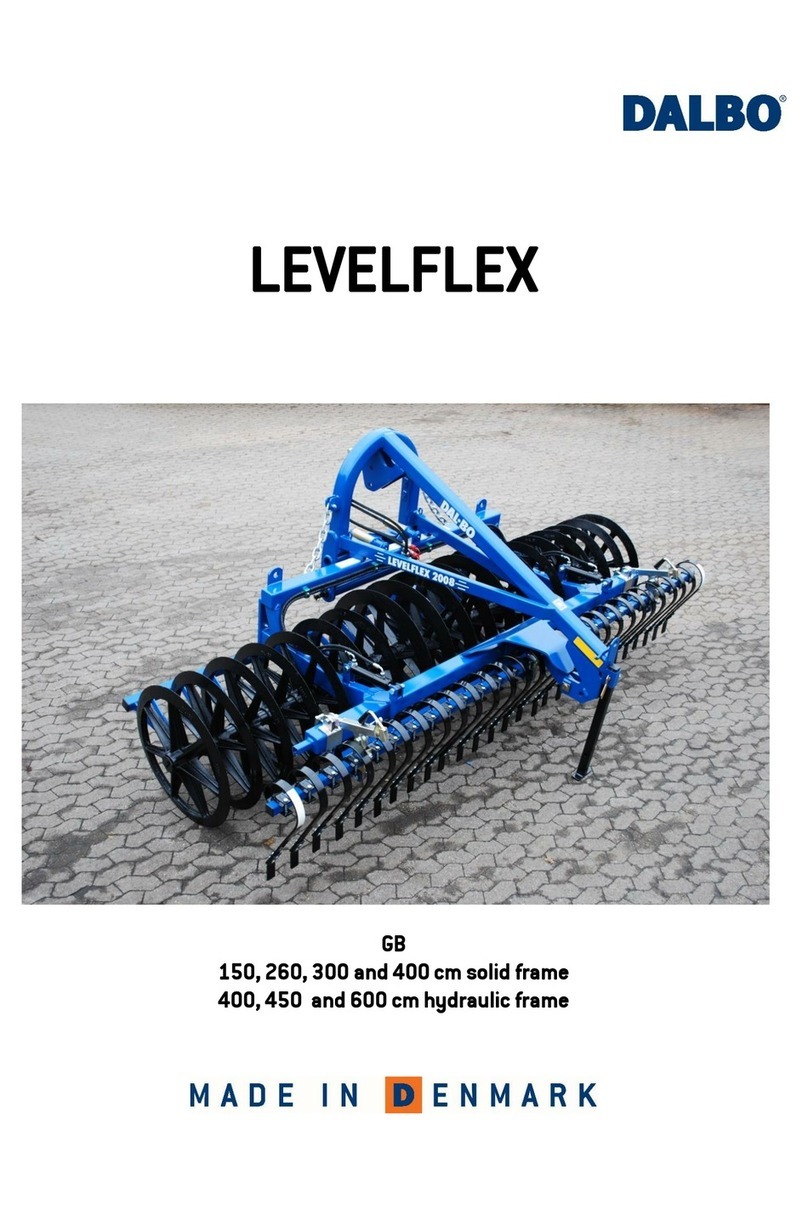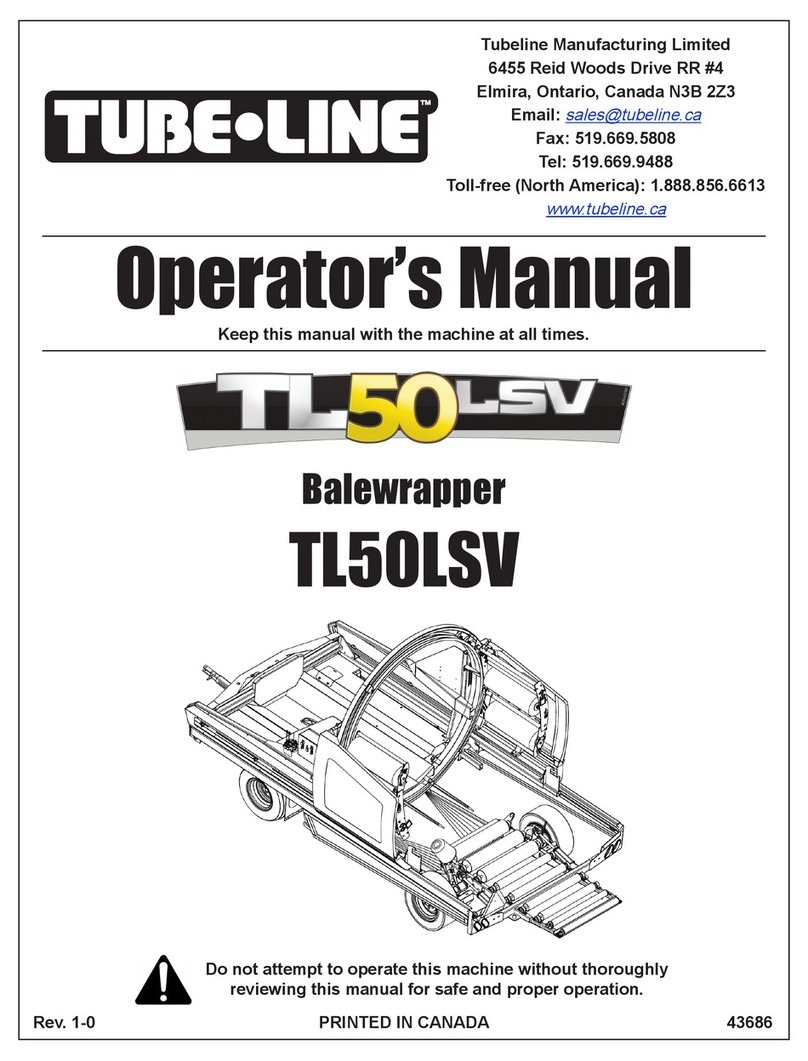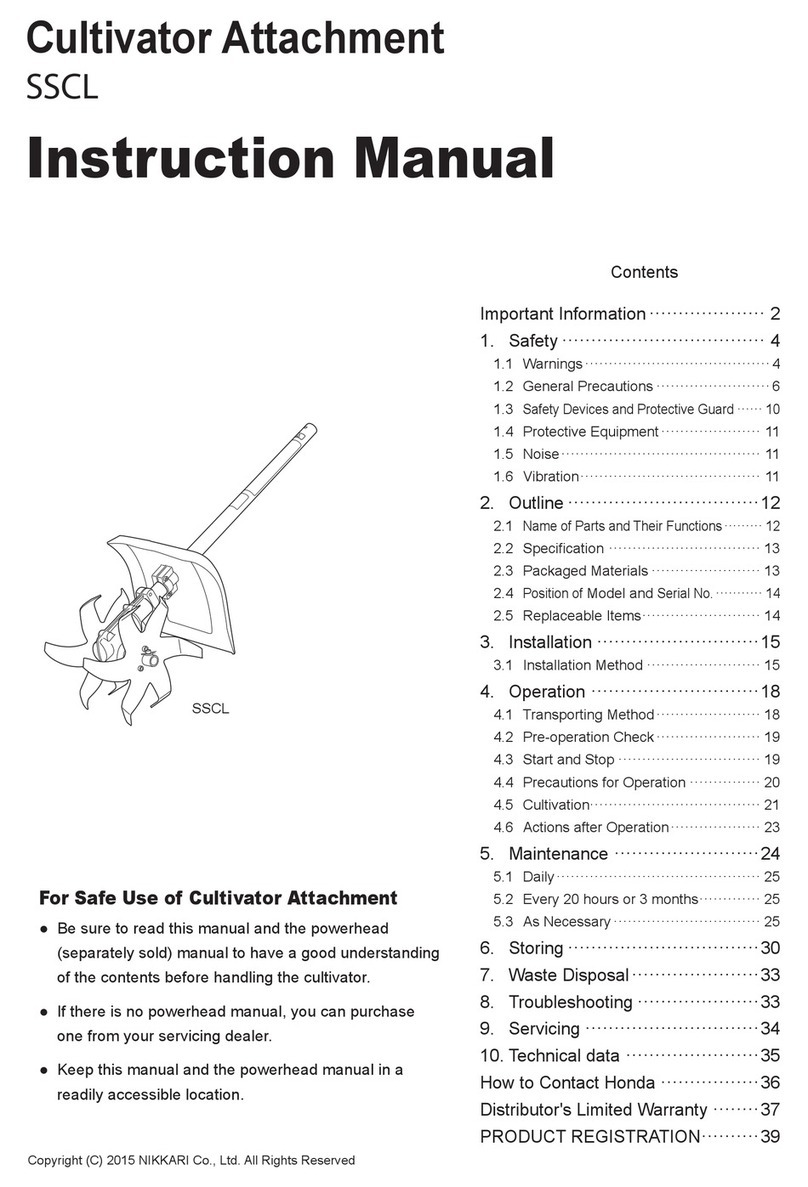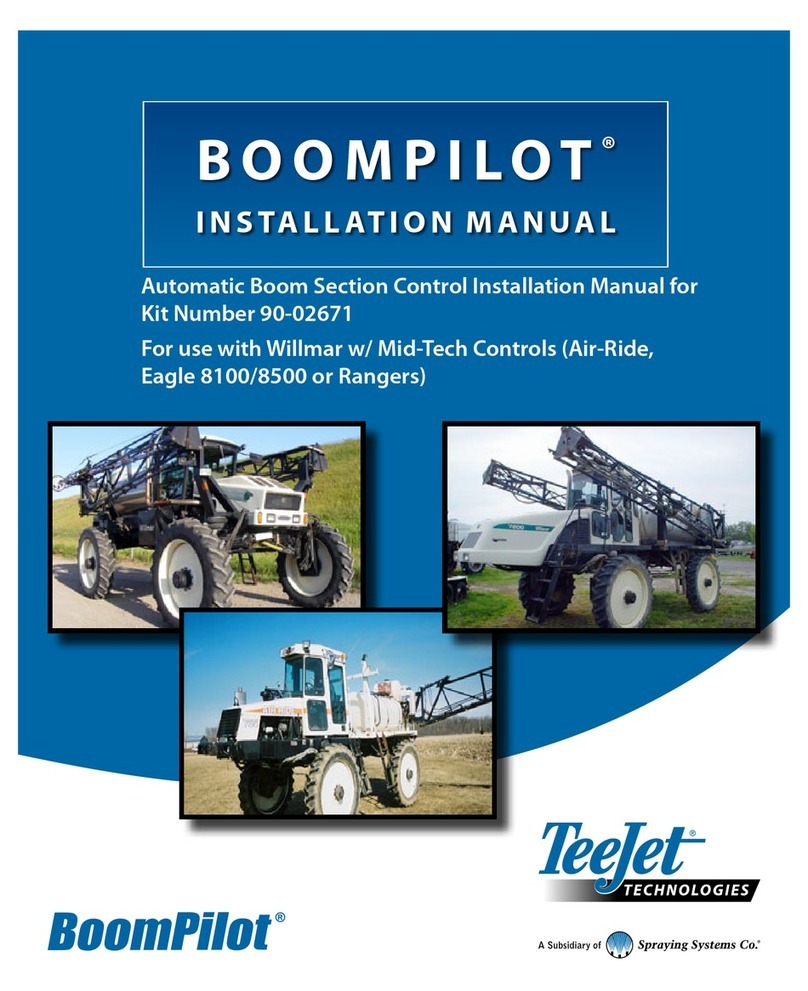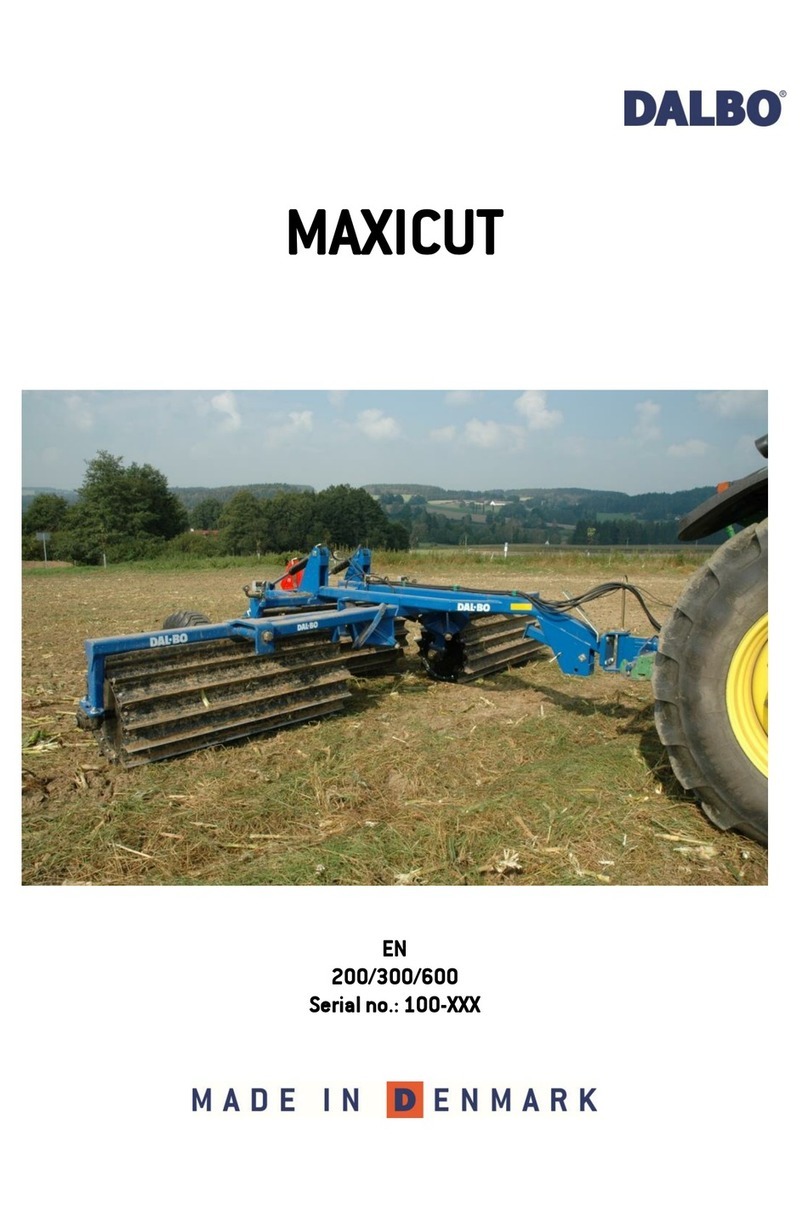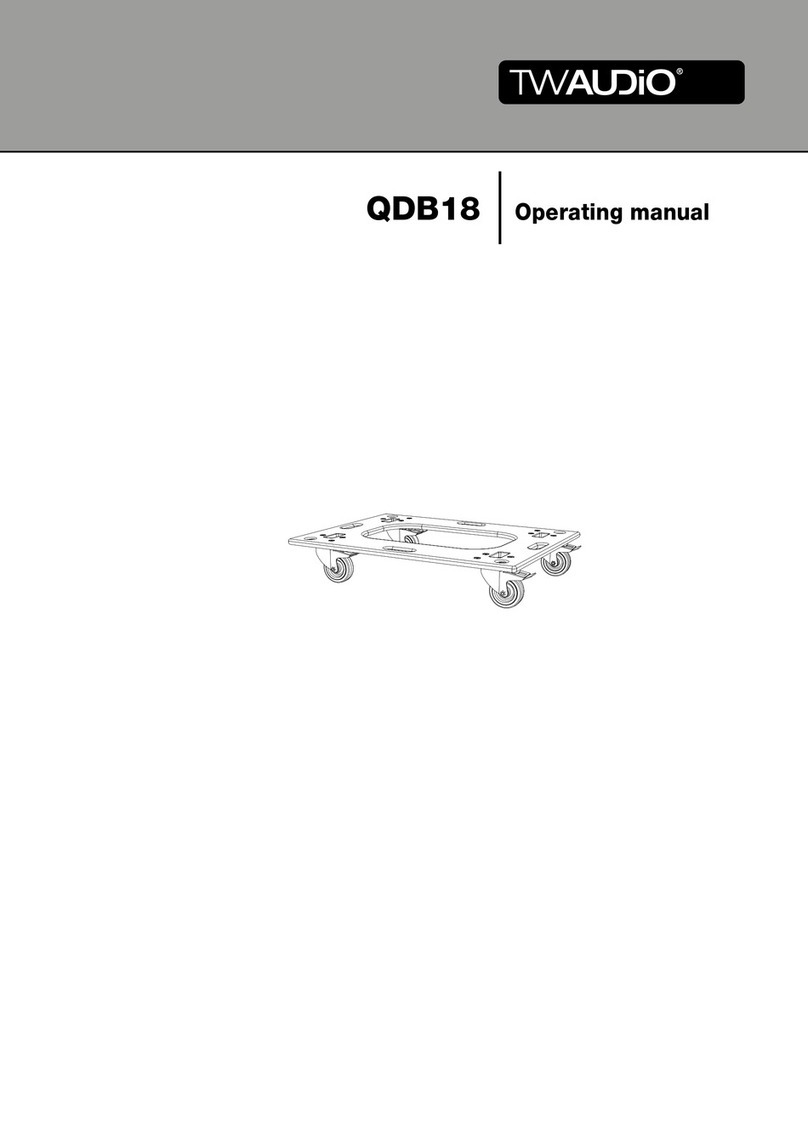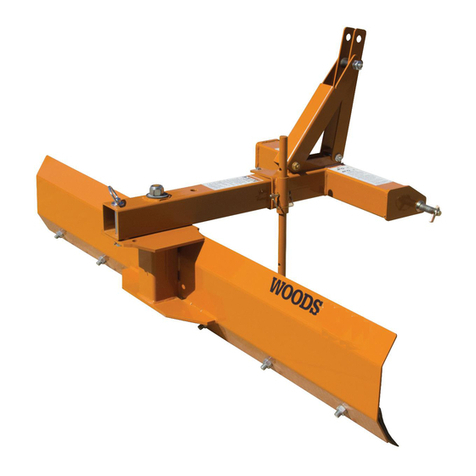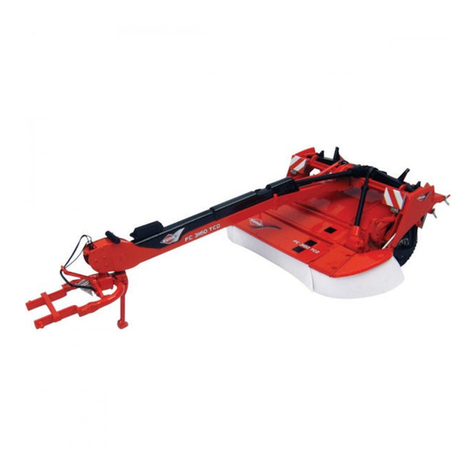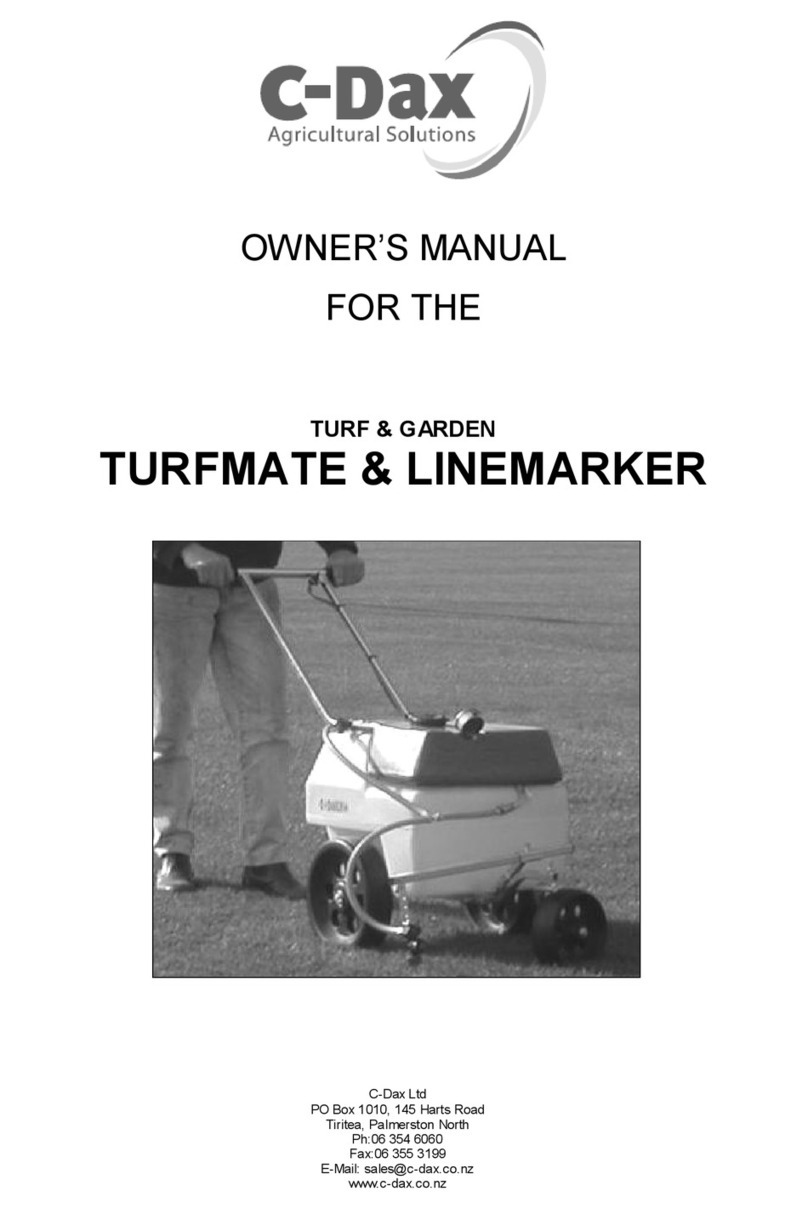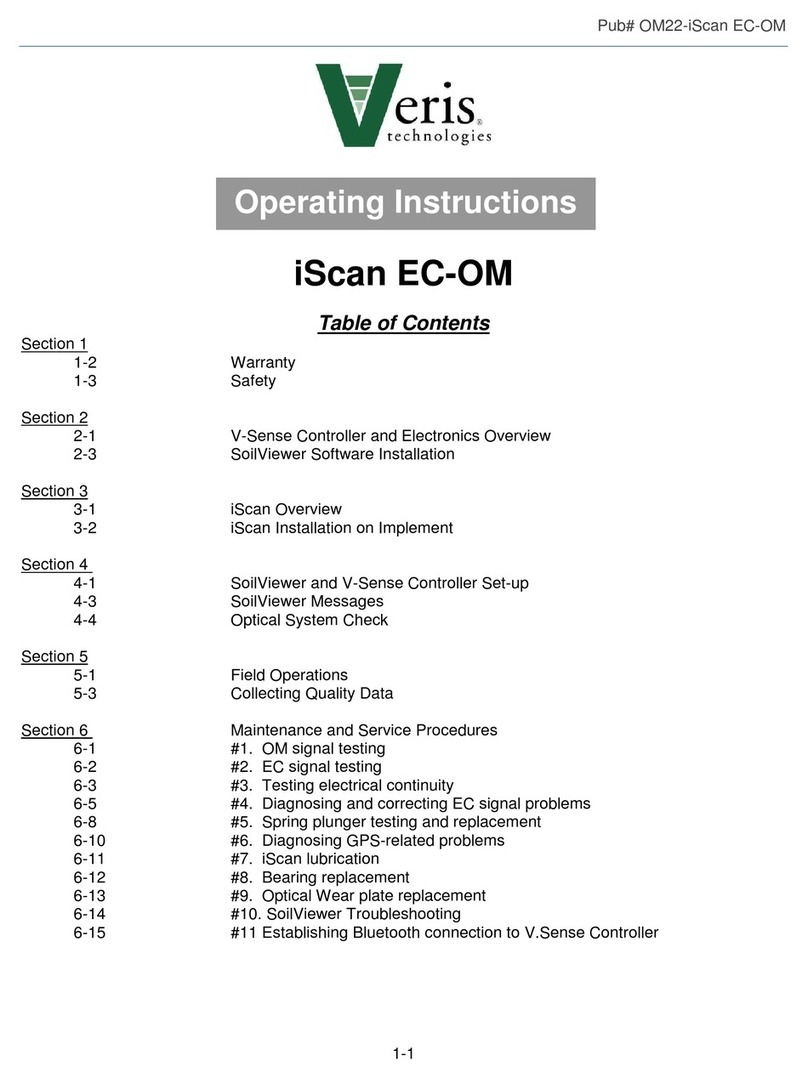HARRISTON INDUSTRIES 93066 User manual

CLAMP PLANTER
OPERATOR’S MANUAL 2016
INDUSTRIES


Table of Contents
1 INTRODUCTION .............................................................................................................................. 1
2 SAFETY ............................................................................................................................................. 3
2.1 OPERATING SAFETY............................................................................................................... 4
2.2 MAINTENANCE SAFETY............................................................................................... 4
2.3 GENERAL SAFETY................................................................................................................... 5
2.4 CHEMICAL SAFETY................................................................................................................. 6
2.5 HYDRAULIC SAFETY .............................................................................................................. 7
2.6 TRANSPORT SAFETY .............................................................................................................. 7
2.7 STORAGE SAFETY ................................................................................................................... 7
2.8 TIRE SAFETY............................................................................................................................. 8
2.9 ASSEMBLY SAFETY ................................................................................................................ 8
2.10 SAFETY DECALS...................................................................................................................... 8
2.11 SIGN-OFF FORM ....................................................................................................................... 9
3 SAFETY DECAL LOCATIONS ..................................................................................................... 10
4 OPERATION.................................................................................................................................... 18
4.1 TO THE NEW OPERATOR OR OWNER ............................................................................... 18
4.2 PRINCIPLE COMPONENTS ................................................................................................... 19
4.3 PRE-START AND BREAK IN................................................................................................. 20
4.4 PRE OPERATION CHECKLIST.............................................................................................. 21
4.5 EQUIPMENT MATCHING ...................................................................................................... 22
4.6 HARRISTON HYDRAULIC CONTROL SYSTEM................................................................ 23
4.6.1 PRESSURE-FLOW COMPENSATED SYSTEM ................................................................ 23
4.6.2 HARRISTON HYDRAULIC DRIVE DIAGRAM (WITH FERTILIZER)..................... 24
4.6.3 MASTER LIST OF SOFT-KEYS..................................................................................... 25
4.6.4 PLANTER VIEW.............................................................................................................. 26
4.6.5 MAIN SCREEN................................................................................................................. 27
4.6.6 JOG SCREEN.................................................................................................................... 28
4.6.7 STATS SCREEN............................................................................................................... 29
4.6.9 RADAR CALIBRATION SCREEN................................................................................. 36
4.6.11 TECH SETUP SCREEN.................................................................................................... 38
4.6.12 FACTORY SETUP SCREEN ........................................................................................... 39
4.6.13 TROUBLESHOOTING..................................................................................................... 40
4.7 SPEED SENSOR (ENCODER) INSTALLATION INSTRUCTIONS..................................... 42
4.8 ATTACHING TRACTOR......................................................................................................... 43
4.9 DAILY INSPECTION............................................................................................................... 44
4.10 MACHINE SETTINGS ............................................................................................................. 45
4.10.1 GAUGE WHEELS ............................................................................................................. 45

4.10.2 CLAMP WHEEL/SEED BOWL CLEARANCE.............................................................. 46
4.10.3 CLAMP WHEEL CAM..................................................................................................... 47
4.10.4 FEEDBOX CHAIN SPEED.............................................................................................. 49
4.10.5 PLANTER SHOE DEPTH REAR..................................................................................... 49
4.10.6 CLOSING DISC ADJUSTMENTS................................................................................... 49
4.10.7 SEED BOWL VOLUME................................................................................................... 50
4.10.8 FIELD OPERATION......................................................................................................... 51
4.11 OPERATING HINTS ................................................................................................................ 53
4.12 TRANSPORTING ..................................................................................................................... 54
4.13 STORAGE ................................................................................................................................. 55
4.13.1 PLACING IN STORAGE.................................................................................................. 55
4.13.2 REMOVING FROM STORAGE...................................................................................... 57
5 SERVICE AND MAINTENANCE.................................................................................................. 58
5.1 SERVICE................................................................................................................................... 58
5.1.1 FLUIDS AND LUBRICANTS........................................................................................... 58
5.1.2 GREASING ........................................................................................................................ 58
5.1.3 SERVICE INTERVALS..................................................................................................... 60
5.2 MAINTENANCE....................................................................................................................... 63
5.2.1 CLAMP WHEEL DRIVE SPROCKET............................................................................. 63
5.2.2 CLAMP WHEEL TO SEED BOWL CLEARANCE......................................................... 63
5.2.3 RETIMING CLAMP WHEELS......................................................................................... 64
5.2.4 ROW UNIT SHEAR BOLTS............................................................................................. 64
5.2.5 HYDRAULICS................................................................................................................... 65
5.2.6 ROLLER CHAIN TENSION............................................................................................. 65
5.2.7 HYDRAULIC DRIVE CHAIN.......................................................................................... 65
5.2.8 CLAMP WHEEL DRIVE CHAIN.................................................................................... 66
5.2.9 FEEDBOX ROLLER CHAIN DRIVE.............................................................................. 66
5.2.10 FEED CHAIN TENSION.................................................................................................. 66
5.2.11 OPERATION OF FEEDBOX MOTOR CONTROL SOLENOID................................... 67
5.2.12 FEEDBOX MOTOR TESTING........................................................................................ 68
5.2.13 REBUILDING SHOES ..................................................................................................... 69
5.2.14 WALKING BEAM TRACKING/ADJUSTMENT........................................................... 69
5.2.15 SERVICING PULSE WIDTH MODULATING (PWM) VALVE................................... 70
6 OPTIONAL EQUIPMENT .............................................................................................................. 73
6.1 ROW MARKERS...................................................................................................................... 73
6.2 PACKER WHEELS................................................................................................................... 73
6.3 HORIZONTAL COIL RIPPER SHANK .................................................................................. 74

6.4 TRASH SHANK........................................................................................................................ 74
6.5 REAR RIPPER........................................................................................................................... 74
7 TROUBLESHOOTING.................................................................................................................... 74
7.1 OPERATING THE PLANTER WITH A FAILED RADAR.................................................... 75
7.2 TESTING PWM VALVES/WIRES. ......................................................................................... 75
7.3 TESTING ENCODERS/WIRES................................................................................................ 76
7.4 MACHINE TROUBLESHOOTING ......................................................................................... 77
7.4.1 HARRISTON DRIVE CONTROL SYSTEM TROUBLE SHOOTING........................... 80
8 SHIPPING AND ASSEMBLY......................................................................................................... 83
9 SPECIFICATIONS........................................................................................................................... 84
9.1 BOLT TORQUE ........................................................................................................................ 84
9.2 HYDRAULIC FITTING TORQUE .......................................................................................... 85
9.3 MECHANICAL......................................................................................................................... 85

1
1 INTRODUCTION
Congratulations on your choice of a Harriston Clamp Potato Planter to complement your farming
operation. This equipment has been designed and manufactured to meet the needs of a discerning potato
industry for the efficient planting of potatoes.
Safe, efficient, and trouble-free operation of your Harriston Planter requires that you and anyone else
who will be operating or maintaining the planter read and understand all of the safety, operation,
maintenance, and troubleshooting information contained in this Operator's Manual.
This manual covers the 4, 6, and 8 row models. Differences are covered and explained where
appropriate.
Keep this manual handy for frequent reference and to pass on to new operators and owners. Call your
Harriston dealer or distributor if you need assistance, information, or additional copies of the manual.
OPERATOR ORIENTATION - The directions left (driver’s side), right (passenger side), front, and
rear, as mentioned throughout the manual, are as seen from the driver's seat and facing in the direction of
travel
Product Line
Code
Year
Code
Production
Number

2
LIMITED WARRANTY
Harriston Industries, hereinafter called Harriston, extends a Limited Warranty on the products it
manufactures to be free from defects in material and workmanship for a period of one (1) year from the
date of sale to the original purchaser. Under this Warranty, parts and labor are covered for replacement
of warrantable parts or components as determined by Harriston. Exclusions to the warranty include
normal wear items and the following parts: tires, planter picks, and accessories installed which are not of
Harriston’s manufacture. No warranty is extended to paint and regular service items such as lubricants.
All warranty work must be done by an authorized Harriston dealer.
The Warranty is void if the product has been subjected to abuse, misuse, misapplication, neglect
(including but not limited to improper maintenance), accident, submersion, improper installation,
modification (including but not limited to use of unauthorized parts), and improper adjustment or repair.
Component parts furnished with Harriston products which are not manufactured by Harriston are not
warranted by Harriston, but are warranted according to the manufacturer of the component part.
THIS WARRANTY IS IN LIEU OF ALL OTHER EXPRESSED OR IMPLIED WARRANTIES.
IMPLIED WARRANTIES INCLUDING THE WARRANTIES OF MERCHANTABILITY OR
FITNESS FOR A PARTICULAR PURPOSE ARE LIMITED TO A PERIOD OF ONE YEAR. Under
no circumstances shall Harriston be obligated for incidental or consequential damages. This warranty
gives you specific legal rights, and you may also have other rights which may vary from state to state
and country to country. Some states and countries do not allow the exclusion or limitation of incidental
or consequential damages, so certain limitations or exclusions under this warranty may not apply to you.
It is expressly understood that the liability of Harriston for its products, whether due to breach of
warranty, negligence, strict liability, or otherwise, is limited to the furnishing or repair of such
replacement parts. Harriston is not liable for any other injury, loss, damage, or expense, whether direct
or consequential, including but not limited to loss of use, income, profit, or increased cost of operation.
Any operation prohibited in the Operator’s Manual or any other manuals furnished with the product, or
any adjustment or assembly procedure not recommended or authorized in the operating or service
instructions shall void such warranty.
No one is authorized to modify this warranty or to make additional warranties on behalf of Harriston.
Harriston reserves the right to change, modify, or improve its products without obligation to retrofit
existing models.
Harriston is not liable for any accidents or damage which may occur from the operation of its
equipment. The purchaser assumes all responsibility for proper use, care, maintenance, and safe
operation.
This warranty is void if the signed warranty registration form is not returned to Harriston within 30 days
of purchase or if serial number has been removed or altered in any way.
Service parts sold and distributed by Harriston carry a 90 day warranty from date of sale.
All warranty claims should be made through the dealer it was purchased from and proof of serial
number and purchase date must be provided when the warranty claim is made. All warranty claims must
be preauthorized by Harriston.
Warranty void if product is not registered

3
2 SAFETY
SAFETY ALERT SYMBOL
This Safety Alert symbol means ATTENTION!
BECOME ALERT! YOUR SAFETY IS
INVOLVED!
3 Big Reasons
Accidents Disable and Kill
Accidents Cost
Accidents Can Be Avoided
The Safety Alert symbol identifies important
safety messages on the Harriston Planter and in
the manual. When you see this symbol, be alert
to the possibility of personal injury or death.
Follow the instructions in the safety message.
SIGNAL WORDS:
Note the use of the signal words DANGER,
WARNING, AND CAUTION with the safety
messages. The appropriate signal word for each
message has been selected using the following
guidelines:
DANGER - An immediate and specific hazard
which WILL result in severe personal injury or
death if the proper precautions are not taken.
WARNING - A specific hazard or unsafe
practice which COULD result in severe personal
injury or death if proper precautions are not
taken.
CAUTION - Unsafe practices which could
result in personal injury if proper practices are
not taken, or as a reminder of good safety
Why is SAFETY Important to you?

4
2.1 OPERATING SAFETY
1. Read and understand the Operator's Manual
and all safety signs before operating,
servicing, adjusting, repairing, unplugging,
or filling.
2. Do not allow riders.
3. Install and secure all guards and shields
before starting or operating.
4. Keep hands, feet, hair, and clothing away
from moving parts.
5. Stop tractor engine, lower machine to the
ground, place all controls in neutral, set
park brake, remove ignition key, and wait
for all moving parts to stop before
servicing, adjusting, repairing, unplugging,
or filling.
6. Place all tractor controls in neutral before
starting.
7. Operate machine only while seated on the
tractor seat.
8. Clear the area of bystanders, especially
small children, before starting.
9. Keep all hydraulic lines, fittings, and
couplers tight and free of leaks before
using.
10. Clean reflectors, slow moving vehicle sign,
and lights before transporting.
11. Add extra lights and use pilot vehicle when
transporting during times of limited
visibility.
12. Use hazard flashers on tractor when
transporting.
13. Install safety chain when attaching to
tractor.
14. Follow chemical manufacturers' handling
and safety instructions exactly when using
chemicals with machine.
15. Review safety instructions with all
operators annually.
2.2 MAINTENANCE SAFETY
Follow all the operating, maintenance, and
safety information in the manual.
Support the machine with blocks or safety
stands when changing tires or working beneath
it.
Stop tractor engine, lower machine to the
ground, place all controls in neutral, set park
brake, remove ignition key, and wait for all
moving parts to stop before servicing, adjusting,
repairing, unplugging, or filling.
Make sure all guards are in place and properly
secured when maintenance work is completed.
Never wear ill-fitting, baggy, or frayed clothing
when working around or on any of the drive
system components.
Before applying pressure to a hydraulic system,
make sure all lines, fittings, and couplers are
tight and in good condition.
Install safety rod and pin securely in position on
hitch cylinder frame before working under
frame.
Relieve pressure from hydraulic circuit before
servicing or disconnecting from tractor.
Keep hands, feet, hair, and clothing away from
moving or rotating parts.
Clear the area of bystanders, especially small
children, when carrying out any maintenance
and repairs or making adjustments.
Wear appropriate protective gear when
contacting chemical handling components on
machine.

5
SAFETY
YOU are responsible for the SAFE operation
and maintenance of your Harriston Potato
Planter. YOU must ensure that you and anyone
else who is going to operate, maintain, or work
around the Planter be familiar with the operating
and maintenance procedures and related
SAFETY information contained in this manual.
This manual will take you step-by-step through
your working day and alerts you to all good
safety practices that should be adhered to while
operating the planter.
Remember, YOU are the key to safety. Good
safety practices not only protect you but also the
people around you. Make these practices a
working part of your safety program. Be certain
that EVERYONE operating this equipment is
familiar with the recommended operating and
maintenance procedures and follows all the
safety precautions. Most accidents can be
prevented. Do not risk injury by ignoring good
safety practices.
Planter owners must give operating instructions
to operators or employees before allowing them
to operate the planter, and at least annually
thereafter per OSHA (Occupational Safety and
Health Administration) regulation 1928.57.
The most important safety device on this
equipment is a SAFE operator. It is the
operator's responsibility to read and understand
ALL safety and operating instructions in the
manual and to follow them. Most accidents can
be avoided.
A person who has not read and understood all
operating and safety instructions is not qualified
to operate the machine. An untrained operator
exposes himself and bystanders to possible
serious injury or death.
Do not modify the equipment in any way.
Unauthorized modification may impair the
function and/or safety and could affect the life
of the equipment.
Think SAFETY! Work SAFELY!
2.3 GENERAL SAFETY
1. Read and understand the
Operator's Manual and
all safety signs before
operating, maintaining,
or adjusting the planter.
2. Provide a first-aid kit
for use in case of an
accident. Store in a
highly visible place.
3. Provide a fire
extinguisher for use in
case of an accident.
Store in a highly visible
place.
4. Wear appropriate
protective gear. This list includes, but is not
limited to:
A hard hat
Protective shoes with
slip resistant soles
Protective glasses or
goggles
Heavy gloves
Wet weather gear
Hearing protection
Respirator or filter mask
5. Install and secure all guards before starting.
6. Do not allow riders.
7. Wear suitable ear
protection for
prolonged exposure
to excessive noise.
8. Stop tractor engine, lower machine to the
ground, place all controls in neutral, set park
brake, remove ignition key, and wait for all
moving parts to stop before servicing,
adjusting, repairing, or unplugging.
9. Clear the area of people, especially small
children, before starting the unit.
10. Review safety related items annually with
all personnel who will be operating or
maintaining the planter.

6
2.4 CHEMICAL SAFETY
1. Some agricultural chemicals are among the
most toxic substances known to man.
Minute quantities can contaminate clothing,
machinery, the workplace, and the
environment. Follow the chemical
manufacturers' instructions exactly. Death
can result from their improper use.
2. Misuse, including excessive rates, uneven
application, and label violations, can cause
injury to crops, livestock, people, and the
environment.
3. Do not breathe, touch, or ingest chemicals or
the dust. Always wear protective clothing
and follow safe handling procedures.
4. Follow the manufacturers' instructions for
chemical storage. Avoid unnecessary
storage by purchasing only the quantity
needed for the crop year.
5. Keep all chemicals out of the reach of
children and away from livestock and
animals.
6. Store chemicals only in their original
containers in a locked area.
7. Check with local authorities regarding the
disposal of small quantities of chemicals,
chemical containers and wash water.
8. Do not burn the containers or leave them
lying in the field or ditches. Take them to
your local container disposal site.
9. Wash thoroughly before eating. Use
detergent to remove all chemical residue.
Rinse carefully and dry with disposable
towels.
10. Do not eat in the field where chemicals are
being applied.
11. In case of chemical poisoning, get
immediate medical attention.
12. Know the Poison Control Emergency
telephone number for your area before using
agricultural chemicals.
United States –1-800-222-1222
Alberta –1-800-332-1414
Manitoba –(204)-787-2591
Ottawa –1-800-267-1373
13. Thoroughly wash clothing and equipment
contaminated by chemicals.
14. Wash the applicators immediately after field
work. Dispose of wash water in an
environmentally safe manner. Wash water
can contaminate the soil or a clean water
supply.

7
2.5 HYDRAULIC SAFETY
1. Make sure that all components in the
hydraulic system are kept in good condition
and are clean.
2. Replace any worn, cut, abraded, flattened, or
crimped hoses and metal lines.
3. Do not attempt any makeshift repairs to the
hydraulic lines, fittings, or hoses by using
tape clamps, or cements. The hydraulic
system operates under extremely high
pressure. Such repairs will fail suddenly and
create a hazardous and unsafe condition.
4. Wear proper hand and eye protection when
searching for a high-pressure hydraulic leak.
Use a piece of wood or cardboard as a
backstop instead of hands to isolate and
identify a leak.
5. If injured by a
concentrated high-
pressure stream of
hydraulic fluid, seek
medical attention
immediately. Serious infection or toxic
reaction can develop
from hydraulic fluid
piercing the skin
surface.
6. Before applying pressure to the system,
make sure all components are tight and that
lines, hoses, and couplings are not damaged.
2.6 TRANSPORT SAFETY
1. Make sure you are in compliance with
all local regulations regarding
transporting equipment on public roads
and highways.
2. Make sure the SMV (Slow Moving
Vehicle) emblem and all the lights and
reflectors that are required by the local
highway and transport authorities are in
place, are clean, and can be seen clearly
by all overtaking and oncoming traffic.
3. Do not allow anyone to ride on the
planter or tractor during transport.
4. Do not exceed 20 mph (32 km/h).
Reduce speed on rough roads and
surfaces.
5. Do not transport with a full seed or
fertilizer tank.

8
2.7 Storage Safety
1. Store away from areas of human activity. Do
not permit children to play on or around the
stored machine.
2. Make sure the unit is sitting, or blocked up
firm and solid and will not tip or sink into a
soft area.
3. Cover with a weather - proof tarpaulin and
tie down securely.
2.8 Tire Safety
1. Failure to follow proper procedures when
mounting a tire on a wheel or rim can
produce an explosion which may result in
serious injury or death.
2. Do not attempt to mount a tire unless you
have the proper equipment and experience to
do the job.
3. Have a qualified tire dealer or repair service
perform required tire maintenance.
2.9 Assembly Safety
1. Assemble in an area with sufficient space to
handle the largest component and access to
all sides of machine.
2. Use only lifts, cranes, jacks, and tools, with
sufficient capacity for the load.
3. Use two people to handle the large bulky
components.
4. Do not allow spectators in the working area.
2.10 Safety Decals
1. Keep safety decals and signs clean and
legible at all times.
2. Replace safety decals and signs that are
missing or have become illegible.
3. Replaced parts that displayed a safety sign
should also display the current sign.
4. Safety decals or signs are available from
your Dealer Parts Department.
How to Install Safety Decals:
1. Be sure that the installation area is clean and
dry.
2. Decide on the exact position before you
remove the backing paper.
3. Remove the smallest portion of the split
backing paper.
4. Align the decal over the specified area and
carefully press the small portion with the
exposed sticky backing in place.
5. Slowly peel back the remaining paper and
carefully smooth the remaining portion of
the decal in place.
6. Small air pockets can be pierced with a pin
and smoothed out using the piece of decal
backing paper.

9
2.11 SIGN-OFF FORM
Harriston Industries follows the general Safety Standards specified by the American Society of
Agricultural Engineers (ASAE) and the Occupational Safety and Health Administration (OSHA).
Anyone who will be operating and/or maintaining the Potato Planter must read and clearly understand
ALL Safety, Operating, and Maintenance information presented in this manual.
Do not operate or allow anyone else to operate this equipment until such information has been reviewed.
Annually review this information before the season start-up.
Make these periodic reviews of Safety and Operation a standard practice for all of your equipment. We
feel that an untrained operator is unqualified to operate this machine.
A sign-off sheet is provided for your record keeping to show that all personnel who will be working with
the equipment have read and understand the information in the Operator's Manual and have been
instructed in the operation of the equipment.
SIGN OFF FORM
Date
Employees Signature
Employers Signature

10
3 SAFETY DECAL LOCATIONS
The types of decals and locations on the equipment are shown in the illustration below. Good safety
requires that you familiarize yourself with the various safety decals, the type of warning, and the area or
particular function related to that area, that requires your SAFETY AWARENESS.
1
24
1
6
7
5
11
12
6
1
2
4
1
1
14
7
9
21
21
24

11
SAFETY DECAL LOCATIONS
10
1
5
4
3
7
9
3
24
21
22,23
21
4
24

12
SAFETY DECAL LOCATIONS
15
8

13
SAFETY DECAL LOCATIONS
Fertilizer Attachment
11
9
17
15
17& 16
15
17

14
SAFETY DECAL LOCATIONS
Fertilizer Attachment
18
11

15
3.1 SAFETY DECALS
The types of decals and locations on the equipment are shown in the illustration below. Good safety requires that
you familiarize yourself with the various Safety Decals, the type of warning, and the area or particular function
related to that area, that requires your SAFETY AWARENESS.
5
1
11
REMEMBER - If Safety Decals have been damaged, removed, become illegible, or parts replaced without decals,
new decals must be applied. New decals are available from your authorized dealer.
Table of contents
